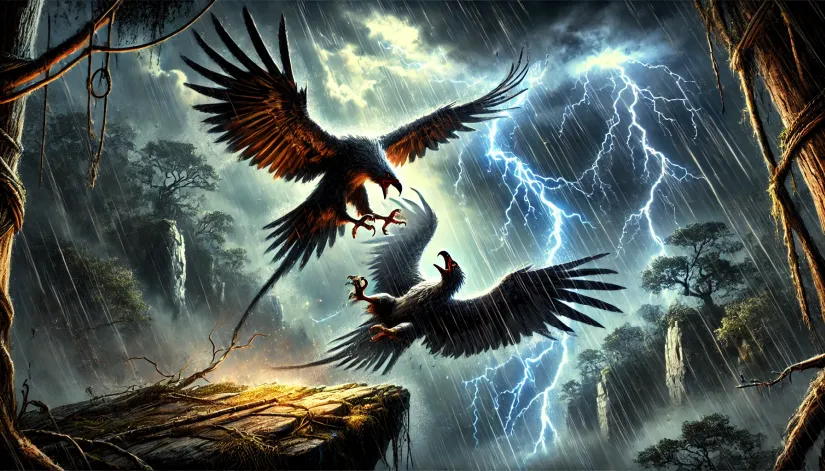The Impundulu is a terrifying African cryptid known for its formidable control over storms and lightning. This mythical creature—deeply embedded in the traditions of the Xhosa and Zulu people—is both feared and revered for its dual abilities to heal and harm.
It’s a flying monstrosity frequently depicted as a potent symbol of malevolence, death, and the arcane arts, capable of instilling dread with a mere mention of its name.
But how much of the legends is real, and how much is made up? And is there any evidence of such a monster ever existed? Let’s find out.
In this article:
Brief Introduction to the Impundulu
Origins and Historical Background
The Impundulu (also known as Lightning Bird, vampire bird, thekwane, izulu, or inyoni yezulu) has deep roots in African history, first appearing in old stories of the Xhosa and Zulu peoples.
The earliest known references to a monstrous bird date back centuries. It was often depicted as a human-sized bird that could summon lightning and thunder.
However, many experts believe these depictions are not just fantastical tales; they actually reflect the tribes’ reverence and fear for the natural elements and their belief in the supernatural.
The Impundulu myth evolved significantly during key historical periods (such as the rise of the Zulu Kingdom in the early 19th century). What changed?
For example, the Lightning Bird was initially primarily viewed as a natural force capable of summoning lightning and thunderstorms.
However, as the Zulu Kingdom grew in power, the Impundulu’s myth expanded, symbolizing both mystical power and political authority—plus its dual nature as a healer and a harbinger of destruction.

Cultural Significance in African Folklore
In traditional Pondo, Xhosa, and Zulu stories, the Impundulu is often depicted as both a bringer of destruction and a healer (as mentioned).
But while each region has its own unique interpretation of this cryptid, all share a common thread.
This is especially true when it comes to the cryptid’s appearance, which is often described as large with dark, shiny plumage and glowing red eyes (but more on this later).
Did you know?
The Owlman, a cryptid from Cornwall, England, is described as a human-sized owl with glowing red eyes. It was first reported in the 1970s and is often linked to the Mothman sightings in the United States.
It’s also fascinating how many of these stories were passed down through generations and frequently incorporated into songs and rituals.
Even today, during thunderstorms, it’s not unusual for elders to recount tales of the Lightning Bird, using its myth to explain the natural phenomenon.
This practice not only preserves the legend but also instills respect for nature’s power in younger generations.
Physical Description and Characteristics
Visual Appearance
The Impundulu has a striking and formidable appearance. It is typically depicted as a bird of substantial size—comparable to an eagle or a large heron.
Its plumage is predominantly dark, with feathers that glisten in black and dark blue shades.
But Impundulu’s most distinctive feature is its glowing red eyes (which are said to pierce even through the darkest night).
Its wingspan is also more than impressive. Broad enough to block out the sun when in full flight.
The bird’s beak and claws are sharp and menacing, capable of inflicting severe damage on any creature unlucky enough to encounter this African cryptid. Truly befitting its association with storms and lightning.
Now, if we compare the Lightning Bird to known bird species, we can easily notice similarities with the African fish eagle and the marabou stork, particularly in size and the imposing nature of its presence.
However, the mythical attributes (such as its electrifying plumage and the ability to summon storms) clearly set it apart as a legendary beast rather than a mere bird of prey.

Behaviors and Habits
Impundulu’s behavior is truly fascinating. At least, according to legends.
The Lightning Bird is primarily active during thunderstorms (when it is believed to summon lightning and thunder). This behavior has led to its association with rain and stormy weather, and it is often seen as a herald of both devastation and fertility.
Did you know?
The Ahool, a giant bat-like creature from Java, Indonesia, is often described as having a wingspan of up to 10 feet and a distinctive cry that sounds like “a-hoo.”
During calm days, the Impundulu remains hidden, resting in secluded spots like dense forests or rocky cliffs.
But as night falls—especially during stormy seasons—it becomes more active, soaring through the skies and unleashing its elemental powers.
Supernatural Abilities and Powers
Association with Lightning and Storms
As mentioned above, the Impundulu is intrinsically linked to lightning and thunderstorms. It can control nature and summon powerful natural elements.
During storms, the bird soars through stormy skies, flying as fast as the lightning and booming thunderclaps. Its flight path traces the jagged streaks of lightning while its cries are echoed in the rumbling of thunder.
Certain rituals and practices have developed around the Impundulu’s supposed powers. For instance, people invoke the mystical bird during drought with specific chants and offerings meant to attract its attention and bring much-needed rain.
Conversely, to protect against its wrath during thunderstorms, rituals might include offerings or prayers designed to appease the creature and prevent harm.

Healing and Harmful Powers
The Impundulu’s supernatural abilities extend beyond weather manipulation.
As a healer, many believe this African cryptid can cure various ailments. Traditional healers or shamans (known in some regions as sangomas) may call upon the Impundulu’s power to treat illnesses.
African healers often use what they believe to be parts of the Impundulu in their healing practices—though it’s very unlikely these items are actual parts of the cryptid.
Its “feathers,” “bones,” or even “essence” are sometimes used in medicinal preparations or healing rituals.
For example, “feathers” are ground into a fine powder and mixed with herbal components (like aloe vera or African ginger).
Did you know?
In the folklore of the Caribbean, the Soucouyant is a shape-shifting creature that can transform into a fireball and fly. It is said to suck the blood of its victims at night, similar to vampire myths.
The resulting mixture is then used to create ointments or potions that are applied to the skin or ingested to treat ailments (such as fever, skin conditions, and infections) that are difficult to treat with conventional methods.
On the flip side, specific ailments (like sudden, unexplained illnesses or persistent bad luck) are often attributed to the maleficence of the Impundulu.

Role in Magic and Witchcraft
We also find one other characteristic of the Impundulu fascinating: its strange association with European vampires. What does an African cryptid have to do with vampires?
Well, Impundulu is also known as the “vampire bird”—a reputation rooted in its alleged shapeshifting and blood-draining powers.
In some tales, the bird can transform into a strikingly beautiful human (often a woman) who uses her charms to seduce and manipulate unsuspecting victims.
Related:
- Mongolian Death Worm: Fact or Fiction? Inside the Gobi Desert’s Greatest Mystery
- Is the Flatwoods Monster Real? An In-Depth Investigation of the 1952 Sighting
- The Wolf of Ansbach: Werewolf Terror in 17th Century Bavaria?
In its human form, it can drain the blood of its prey (similar to the behavior of traditional vampires). This blood-draining ability is often depicted in tales involving witchcraft and dark magic.
The bird must feed on the blood of its victims to sustain its power and longevity, further cementing its association with vampirism. In return, its victims are often left weak and ill, suffering from unexplained ailments and persistent bad luck.
The Impundulu is also believed to serve witches, acting as a familiar that carries out their malevolent bidding.

Alleged Sightings
Verified Impundulu sightings are scarce and often debated even among cryptozoologists. Most accounts come from rural areas in Southern Africa.
One notable alleged sighting happened in the Eastern Cape of South Africa in the early 20th century, where a farmer reported seeing a large, dark bird with glowing red eyes during a thunderstorm.
The sighting was dramatic. Immediately after the bird’s appearance, a lightning strike split a nearby tree. However, while the account is compelling, it lacks physical evidence.
In another instance, villagers in KwaZulu-Natal in the 1960s claimed to witness the Impundulu during a nighttime ceremony.
This time, we have multiple witnesses. All described seeing a massive bird with iridescent feathers emitting sparks, lending some credibility to the story through their consistent descriptions. But again, there is no physical evidence whatsoever.
Recently, some sporadic sightings have been shared through social media and local news outlets.
For example, a tourist in Zimbabwe in 2010 reported seeing a large, eagle-like bird during a thunderstorm while on safari. The guide, familiar with the legend, suggested it might be the Impundulu. However, no physical evidence was found to support this claim.
Comparative Mythology: Impundulu and Other Vampire Birds
One notable counterpart to the Impundulu is the Thunderbird from Native American mythology.
Like the African cryptid, the Thunderbird is associated with storms and powerful natural forces. It is often depicted as a giant bird capable of creating thunder and lightning with its wings.
Both the Impundulu and the Thunderbird serve as symbols of power. They are revered in their respective cultures for their control over the elements.
Did you know?
The Ropen, a cryptid from Papua New Guinea, is said to resemble a pterosaur and is known for its bioluminescent glow, which some believe it uses to attract fish at night.
However, while the Impundulu is sometimes portrayed as malevolent or dangerous, the Thunderbird is more commonly seen as a protective and benevolent figure.
In Filipino folklore, the Tigmamanukan is another mythical bird similar to the African cryptid. It is believed to be a harbinger of omens, often associated with weather changes and significant events.
It shares the Impundulu’s dual nature, being both a symbol of fortune and a bearer of warnings. Unlike the African Lightning Bird (which is tied to lightning and storms) the Tigmamanukan is more generally linked to various natural phenomena and is considered a guide for travelers and adventurers.
The European myth of the Strix also offers interesting comparisons. The Strix, often depicted as a nocturnal bird with vampiric tendencies, shares the Impundulu’s darker aspects.
Both creatures are associated with witchcraft and can be invoked for malevolent purposes.
The Strix is said to suck the blood of infants and cause illness, paralleling the Impundulu’s role in causing harm and bringing curses. The primary difference lies in their appearances and elemental associations, with the Strix being more of an owl-like figure rather than a storm-linked bird.
Frequently Asked Questions
What is the Impundulu?
The Impundulu, also known as the Lightning Bird, is a mythical creature in African folklore believed to control lightning and storms.
What is the meaning of Impundulu?
In Xhosa and Zulu, “Impundulu” means “Lightning Bird.”
What are the abilities of the African Lightning Bird?
The Impundulu can summon lightning and thunderstorms, heal ailments, and cause harm or illness.
What is the African bird mythology?
African bird mythology involves various mythical birds, like the Impundulu, that possess supernatural powers and play significant roles in folklore.
What is Impundulu in Xhosa?
In Xhosa, the Impundulu is a legendary bird associated with lightning and storms, often feared and revered.
What are the powers of the Impundulu?
The Impundulu can control lightning, cause storms, heal diseases, and bring curses.
How does the Impundulu differ from other mythical birds?
Unlike other mythical birds, the Impundulu is associated explicitly with lightning and storms, which may have different elemental or spiritual associations.
Where is the Impundulu legend most popular in Africa?
The Impundulu legend is most popular among the Xhosa and Zulu people in Southern Africa.
Are there any modern sightings of the Impundulu?
Yes, there have been reported sightings of the Impundulu, particularly during thunderstorms, though their credibility is often debated.
What does the Impundulu look like?
The Impundulu is described as a large bird with dark, shiny plumage and glowing red eyes, resembling an eagle or heron.
How is the Impundulu represented in modern media?
An Impundulu is a primary antagonist in Marlon James’s Dark Star trilogy and appears in both books, Black Leopard, Red Wolf and Moon Witch, and Spider King.
Are there any real birds that might have inspired the Impundulu myth?
Large birds like the African fish eagle and marabou stork, with their imposing presence and habitats, may have inspired the Impundulu myth.







